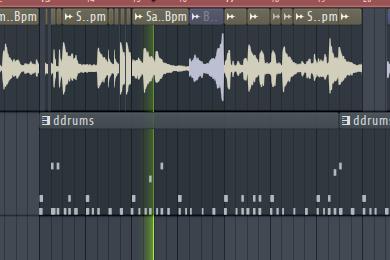Creating unique music sample packs can be a rewarding and profitable endeavor for musicians, producers, and sound designers.
Whether you are an established artist or just starting out, crafting high-quality sample packs can help you showcase your skills, build your brand, and generate income.
Simple steps to start creating sample packs:
- Target an audience: Choose a genre or a theme
- Type of sample pack: Is it going to be focused on one-shots or melodies?
- Structure the sound pack accordingly:
- One-shots should be grouped into their own folder
- Melodic one-shots should also display their key
- Melodies should display the key and BPM
- Drum loops should display the BPM
- Export sounds as WAV’s
In this article, we will explore the essential steps and considerations involved in creating exceptional music sample packs.
Why Create Music Sample Packs?
Before diving into the creation process, it’s important to understand why music sample packs are in demand and why they can benefit both creators and users.
1. Versatility and Inspiration
Music sample packs are a valuable resource for producers, as they provide a wide range of pre-recorded sounds, loops, and one-shots that can be easily incorporated into their own compositions.
With a well-curated sample pack, musicians can enhance their workflow, experiment with new genres, and find inspiration for their creative projects.
- Sample packs offer a diverse range of sounds and musical elements that can be used in various genres and styles, providing producers with endless possibilities for creativity.
- These packs often include professionally recorded and processed sounds, ensuring high-quality results for users.
- By exploring different sample packs, producers can discover unique sounds and textures that they may not have been able to create themselves, thus sparking new ideas and pushing the boundaries of their music.
2. Time-Saving Efficiency
By utilizing music sample packs, producers can save significant time and effort that would otherwise be spent on recording, processing, and editing individual sounds.
These pre-made samples allow users to focus on the artistic aspects of their work rather than spending hours on tedious sound design tasks.
- With a well-organized and curated sample pack, producers can quickly find the sounds they need, eliminating the need for extensive searching or creating sounds from scratch.
- Sample packs often provide ready-to-use loops and patterns, allowing producers to build tracks more efficiently and effectively.
- By streamlining the sound selection process, sample packs enable producers to spend more time on composition, arrangement, and other creative aspects of music production.
3. Professional Quality
Creating a music sample pack requires careful attention to detail and a commitment to delivering high-quality content.
By offering professional-grade samples, musicians can establish themselves as experts in their field and build a reputation for delivering top-notch sound resources.
- Musicians and producers rely on sample packs to enhance the quality of their productions, and they expect samples that are well-recorded, well-processed, and free from technical flaws.
- By consistently delivering high-quality samples, you can build trust and credibility with your audience, positioning yourself as a reliable source of professional-grade sounds.
- A well-crafted sample pack can help you stand out from the competition and attract a loyal following of musicians who appreciate and value the quality of your offerings.
4. Generating Revenue
Aside from the artistic and creative benefits, music sample packs can also serve as a revenue stream. Whether you sell your packs on popular platforms like Splice or through your own website, the demand for quality samples ensures that there is a market for your creations.
- The music production industry is constantly growing, and producers are always on the lookout for new sounds and samples to enhance their productions.
- By pricing your sample packs competitively and marketing them effectively, you can generate a steady stream of income from sales.
- Additionally, offering exclusive or limited edition sample packs can create a sense of urgency and exclusivity, further driving sales and revenue.
Essential Steps in Creating Music Sample Packs
Now that we understand the importance and potential of music sample packs, let’s delve into the essential steps involved in creating them.
1. Define Your Target Audience
Before embarking on the creation process, it’s crucial to identify your target audience. Consider the genre, style, and specific needs of the musicians who would benefit from your sample pack.
Understanding your audience will help you tailor your pack’s content to meet their expectations and preferences.
- Research the market and identify the genres or styles of music that are currently popular or in demand.
- Analyze the needs and preferences of your target audience by studying their music, following trends in the industry, and engaging with them through social media or online communities.
- Consider the skill level and experience of your target audience. Are you catering to beginners, intermediate producers, or advanced professionals? This will dictate the complexity and depth of your sample pack.
2. Research and Curate Sounds
Once you have a clear understanding of your target audience, it’s time to research and curate the sounds for your sample pack.
Explore different sound libraries, experiment with your own recordings, and select a variety of samples that align with your audience’s preferences.
Remember to focus on quality over quantity, as users will value well-crafted and unique sounds.
- Browse through various sound libraries, both free and paid, to gather inspiration and source potential sounds for your pack.
- Experiment with recording your own sounds, whether it’s capturing live instruments, field recordings, or unique textures. This will add a personal touch to your sample pack and make it stand out from the competition.
- Aim for diversity in your sample selection, including different instruments, tempos, moods, and textures. This will ensure that your pack can cater to a wide range of musical styles and preferences.
3. Organize and Label
To ensure a seamless user experience, properly organize and label your sample pack. Create folders or categories that group similar sounds together, such as drums, melodies, vocals, or FX.
SONG NAME – KEY – BPM
DREAM STATE – Dm – 97 BPM
Additionally, provide detailed information and tags for each sample, including BPM, key, and any relevant details that can help users easily navigate and find the desired sounds.
- Use clear and descriptive folder names that accurately represent the content within. Avoid vague or generic names that might confuse or frustrate users.
- Organize your samples into subfolders based on instrument type, sound category, or musical elements. This will make it easier for users to find specific sounds and maintain an organized workflow.
- Take the time to properly label each sample with relevant information such as BPM, key, and any additional notes or descriptions. This will save users valuable time when integrating the samples into their own projects.
4. Format and File Types
Consider the compatibility of your sample pack by offering it in various file formats. Common formats include WAV, AIFF, or REX files, which are widely supported by most digital audio workstations (DAWs).
Most WAV files are exported in 24bit/44.1kHz format.
Additionally, consider offering sampler patches or presets for popular virtual instruments to further enhance the usability of your pack.
- WAV and AIFF formats are the most widely supported and provide high-quality audio without compromising on file size. WAV is by far the most popular format used in sample packs.
- If your sample pack includes melodic or instrument-specific samples, provide sampler patches or presets for popular virtual instruments like Kontakt, Serum, or Massive. This will enable users to easily integrate the samples into their preferred software and manipulate them further.
5. Demo Tracks and Showcase
To entice potential users, create demo tracks that showcase the versatility and potential of your sample pack. These tracks will serve as a preview and provide a glimpse of the creative possibilities that your pack offers.
Share these demo tracks on your website, social media platforms, and other relevant channels to generate interest and drive sales.
- Produce high-quality demo tracks that highlight the different sounds and textures available in your sample pack. Showcase how the samples can be used in different genres or styles of music.
- Experiment with different combinations of samples to demonstrate the versatility and flexibility of your pack. Show users how they can layer, manipulate, or process the samples to create unique and original compositions.
- Share these demo tracks on platforms such as SoundCloud, YouTube, or your own website. Use engaging visuals and informative descriptions to captivate potential users and encourage them to explore your sample pack further.
6. Packaging and Presentation
Pay attention to the packaging and presentation of your sample pack. Design visually appealing cover art that captures the essence of your pack and conveys its style and genre.
Additionally, create an engaging product description that highlights the key features and benefits of your pack.
These elements contribute to the overall perceived value and appeal of your offering.
- Create a visually striking cover art that represents the mood, genre, or theme of your sample pack. Use high-quality graphics, typography, and colors that resonate with your target audience.
- Craft a compelling product description that clearly outlines the contents of your pack, its unique selling points, and the benefits it offers to users. Use persuasive language and focus on the value that users will gain from purchasing and using your samples.
- Consider offering additional bonuses or extras, such as exclusive presets, MIDI files, or tutorial videos, to further enhance the perceived value of your sample pack.
7. Promotion and Distribution
Once your sample pack is ready, it’s time to promote and distribute it. Leverage your existing online presence, such as your website, social media, and mailing list, to reach your target audience.
Additionally, consider partnering with online platforms and marketplaces specialized in music production resources, such as Splice or Loopmasters, to gain wider exposure and reach a larger user base.
- Create a dedicated landing page on your website for your sample pack, showcasing its features, benefits, and purchase options. Optimize this page for search engines to improve its visibility.
- Utilize social media platforms to share teasers, behind-the-scenes content, and updates about your sample pack. Engage with your audience, respond to inquiries, and encourage user-generated content such as reviews or demos.
- Explore collaborations or partnerships with popular music production influencers or platforms to amplify your reach and tap into their existing audiences.
- Consider offering limited-time promotions, discounts, or bundle deals to incentivize users to purchase your sample pack and create a sense of urgency.
8. Gather Feedback and Improve
Actively seek feedback from users who have purchased and utilized your sample pack. Listen to their suggestions, address any issues or concerns, and continuously improve and update your pack based on their feedback.
This iterative process will help you refine your offerings and maintain a loyal customer base.
- Encourage users to provide feedback through surveys, reviews, or direct communication channels. Ask them about their experience with your sample pack, any improvements they would like to see, and any additional content they would find valuable.
- Regularly update and expand your sample pack based on user feedback and evolving industry trends. This demonstrates your commitment to delivering a high-quality product and keeps your offerings fresh and relevant.
- Engage with your audience on social media or online communities to foster a sense of community and gather valuable insights and ideas for future sample packs.
Conclusion
Creating music sample packs is an exciting and rewarding endeavor that enables musicians to showcase their skills, provide valuable resources to fellow producers, and generate income.
By following the essential steps outlined in this article, you can create exceptional sample packs that cater to the needs of your target audience, establish your brand, and contribute to the vibrant music production community.
FAQ
1. Why should I create music sample packs?
Creating music sample packs allows you to provide a versatile and inspiring resource for producers, saving them time and effort in sound design.
It also helps establish yourself as an expert in your field and can generate a steady stream of income.
2. How do I define my target audience for a sample pack?
To define your target audience, research the market and identify popular genres or styles. Analyze the needs and preferences of your audience by studying their music and engaging with them through social media. Consider their skill level and experience to tailor your sample pack accordingly.
3. How do I organize and label my sample pack?
To ensure a seamless user experience, create clear and descriptive folder names and organize your samples into subfolders based on instrument type, sound category, or musical elements.

Label each sample with relevant information such as BPM, key, and any additional notes or descriptions.

4. How should I promote and distribute my sample pack?
Promote your sample pack by creating a dedicated landing page on your website, utilizing social media platforms, and exploring collaborations with influencers or platforms.
Consider offering limited-time promotions or discounts. Distribute your pack through online platforms and marketplaces specialized in music production resources.




